Assignment 3: Narrative Writing | English Language for GCSE/IGCSE - Year 11 PDF Download
| Table of contents |

|
| Introduction |

|
| Overview |

|
| Assignment Examples |

|
| How to write to narrate |

|
| Narrative Writing Techniques |

|
| Linguistic Devices |

|
| Top Tips |

|
Introduction
In Assignment 3 of your coursework portfolio, you'll be tasked with producing a narrative piece. To achieve the top marks, you must craft a richly developed plot with clear structure, incorporating elements of fiction writing like character development and setting.
The following guide is divided into the following sections:
- Overview
- Assignment Examples
- How to Write to Narrate
- Narrative Writing Techniques
- Top Tips
Overview
In this assignment, your writing skills will be assessed. Your piece should be between 500 and 800 words long. Marks are allocated as follows: 10 marks for content and structure, and 15 marks for style and accuracy.

Narratives can take various forms, including the beginning or conclusion of a larger tale or a standalone short story, but they should exhibit characteristics of fiction writing. Your concepts should be creatively explored and expanded upon. Keep in mind that a compelling story is typically a successful one!
Assignment Examples
You might receive a task to create a narrative that builds tension and mood, or one that delves into interpersonal connections and feelings. Another possibility is to craft a story centered around adventure, accomplishment, or unexpected occurrences. Any approach that speaks directly to specific readers while holding their interest and involvement is acceptable. The most compelling short stories revolve around a single plot concept, feature a maximum of two primary characters, and are often situated in a familiar setting.
How to write to narrate
Narrative story writing involves developing an idea towards a conclusion. To excel in exams, it is crucial to plan an ending with a resolution. This planning should include deciding whether the story will conclude happily or not.
Adhering to the conventions of story writing is essential. To do this effectively:
- Planning Your Writing:
- Organize your writing to take your characters and readers through a clear journey.
- One effective method is to structure your plot around a central event.
- Ensure that your storyline is straightforward, making it easy to follow and logically connected.
- Structural Techniques:
- Utilize tools like flashbacks to provide additional context and background information to your audience.
- When employing flashbacks, use past-tense verbs to maintain consistency.
- Character Development:
- Explore key character archetypes like the villain, victim, and hero to enrich your narrative.
- Decide how your characters embody these archetypes within the story.
- Descriptive Writing:
- Focus on pertinent details when describing characters, emphasizing elements like body language and gestures.
- Utilize dialogue to reveal character traits through speech verbs like "shrieked," "mumbled," or "whispered."
- Repetition of descriptive elements, such as colors, can reinforce themes and ideas within your writing.
- Repeat concepts for emphasis, enhancing the impact of ideas within your narrative.
- Exploring Character Development in Writing:
- You could focus on their body language or movements
- If using dialogue, the verbs you use to describe how your characters speak can reveal more about them than what they say, for example, "shrieked", "mumbled", "whispered"
- It is effective to repeat ideas related to color
- You can repeat ideas for emphasis, such as black and grey or green and blue
It's important to structure narrative writing responses into five or six paragraphs. Careful planning is essential due to the limited time available, as an unplanned response may result in an abrupt or incomplete ending, leading to lower marks.
Various narrative structures or arcs can be utilized for planning your story within the 15-minute timeframe. A controlled and concise story can be achieved by considering a five-part narrative structure, such as Freytag’s Pyramid:
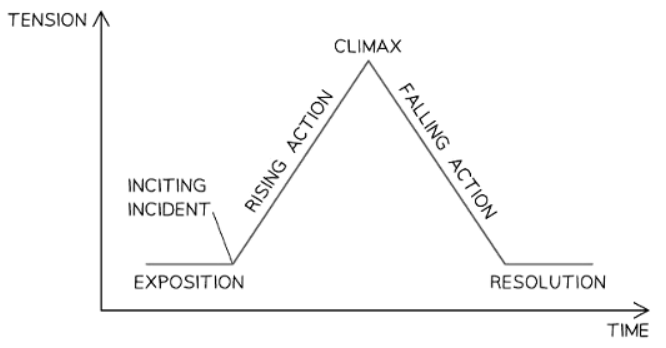
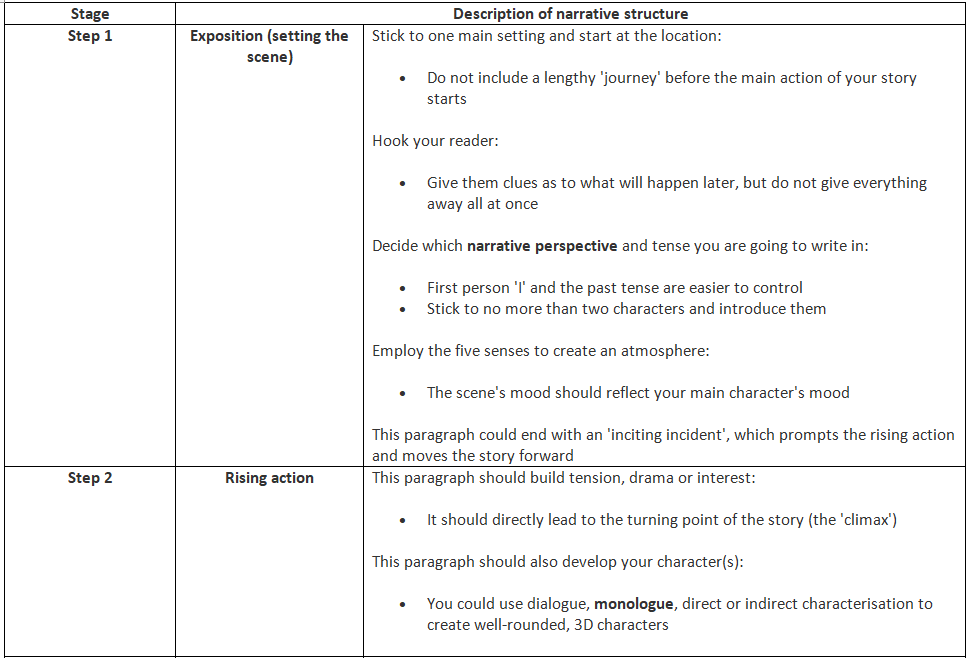
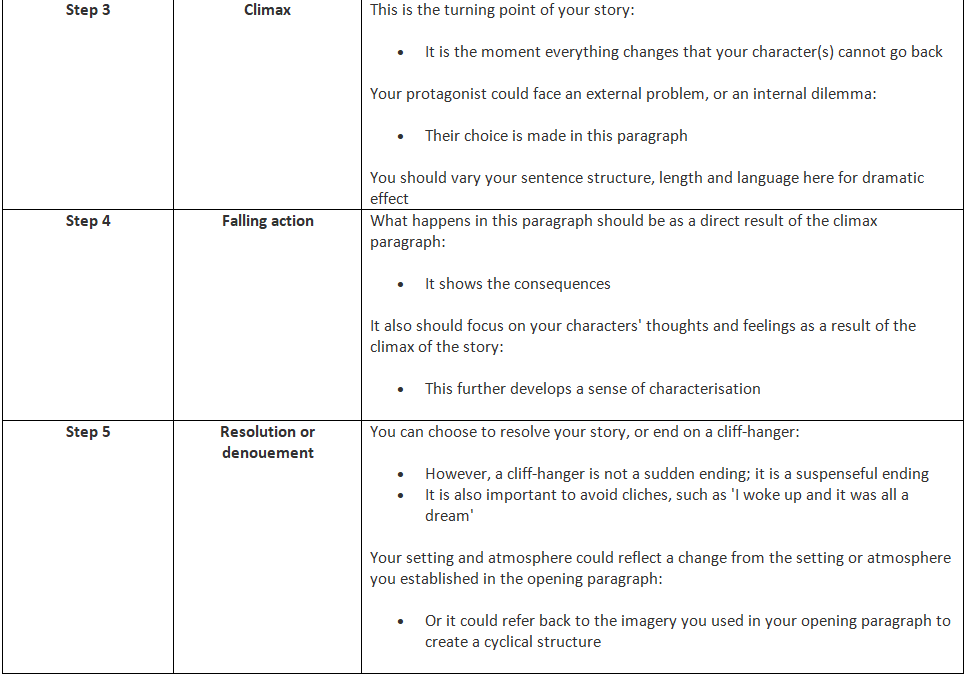
It's beneficial to vary the lengths of paragraphs in your narrative writing. What matters most is developing distinct ideas or points in each paragraph and avoiding repetitive descriptions throughout your response.
Narrative Writing Techniques
After outlining the structure of your narrative, it's advisable to contemplate integrating methods and techniques into your writing. Below are some pointers to assist you in considering setting, characterisation, and other linguistic techniques to enhance the engagement of your narrative.
Setting
This task evaluates one's capacity to communicate with clarity, effectiveness, and imagination. It's crucial to contemplate the constructive use of language in crafting a short story to evoke atmosphere or mood. Establishing an effective setting is paramount as it significantly influences the atmosphere and mood of the narrative.
- Align your setting with your main character's emotions, a technique known as pathetic fallacy. For instance, describing "the lonely road" to reflect the character's mood.
- Allow your setting to evolve alongside your character's emotional journey. This could involve transitioning from a sunny afternoon to a stormy evening, for example.
- Contrasting scenes effectively convey ideas and captivate readers. For instance, starting with a sunny afternoon and ending with an approaching storm.
- Ensure that the contrast in scenes reflects the character's mood consistently throughout the narrative.
- Establish a clear setting before introducing other elements, such as character development.
- Use sensory language to describe the setting comprehensively, appealing to all five senses.
- Dedicate an entire paragraph to describe the scene, focusing solely on setting details to avoid confusion.
- Maintain consistency in the mood conveyed by your descriptive language throughout the narrative.
- Avoid revealing too much information all at once to keep readers engaged and curious.
- Establishing a setting is akin to the game "Taboo," where you describe something without explicitly stating what it is, allowing readers to interpret and engage with the narrative actively.
Characterisation
This task requires you to craft a short story, necessitating detailed character development. Characters should embody certain themes or concepts, such as hope, strength, abandonment, or injustice. It's advisable to limit the number of characters to two within the given time constraints.
Effective characters undergo a journey or transformation throughout the narrative. They should experience some form of development or change to make the story compelling. The assessment criteria favor responses that skillfully convey ideas, emphasizing the importance of employing indirect characterisation techniques over direct methods. Here, we will consider how to plan your character(s) effectively to engage your reader. This is what the examiner is looking for in your answer:
Here, we will consider how to plan your character(s) effectively to engage your reader. This is what the examiner is looking for in your answer: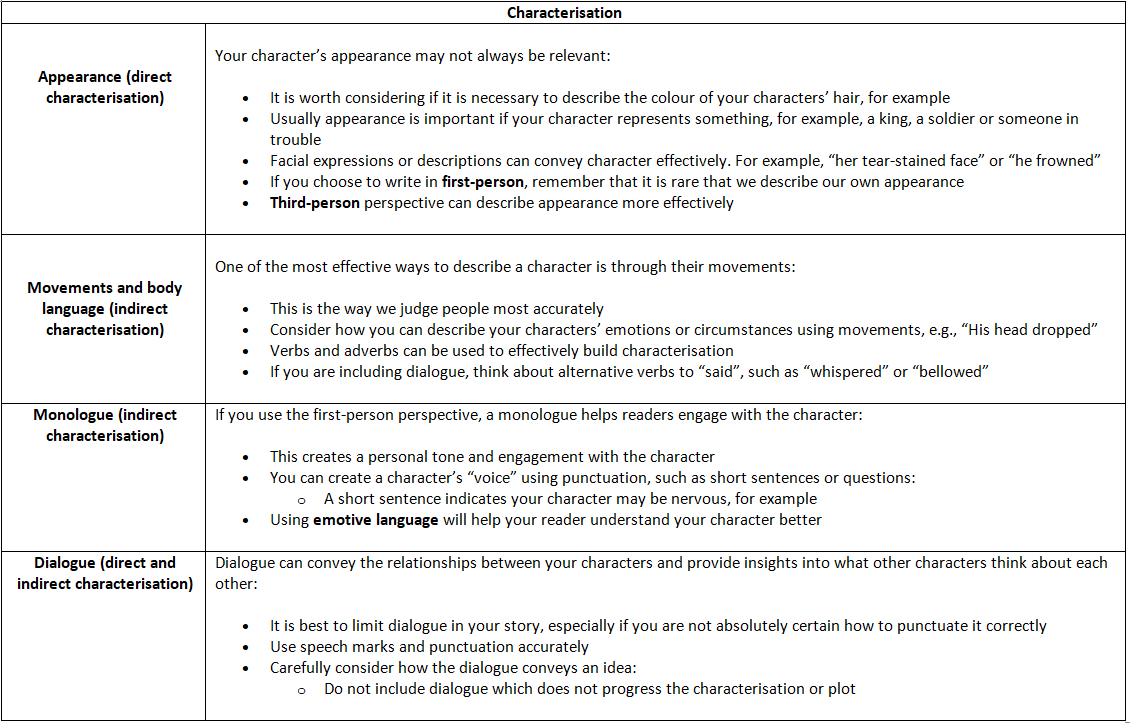
Linguistic Devices
When selecting your language and techniques, remember that each choice should serve a specific purpose. Consider the implied meanings and associations of words and phrases, as they can enrich your writing by evoking particular emotions or revealing aspects of characters. Utilize the "show, not tell" principle to immerse the reader in your narrative.
Below you will find a brief explanation of some of the key techniques you could employ in your narrative (or descriptive) writing: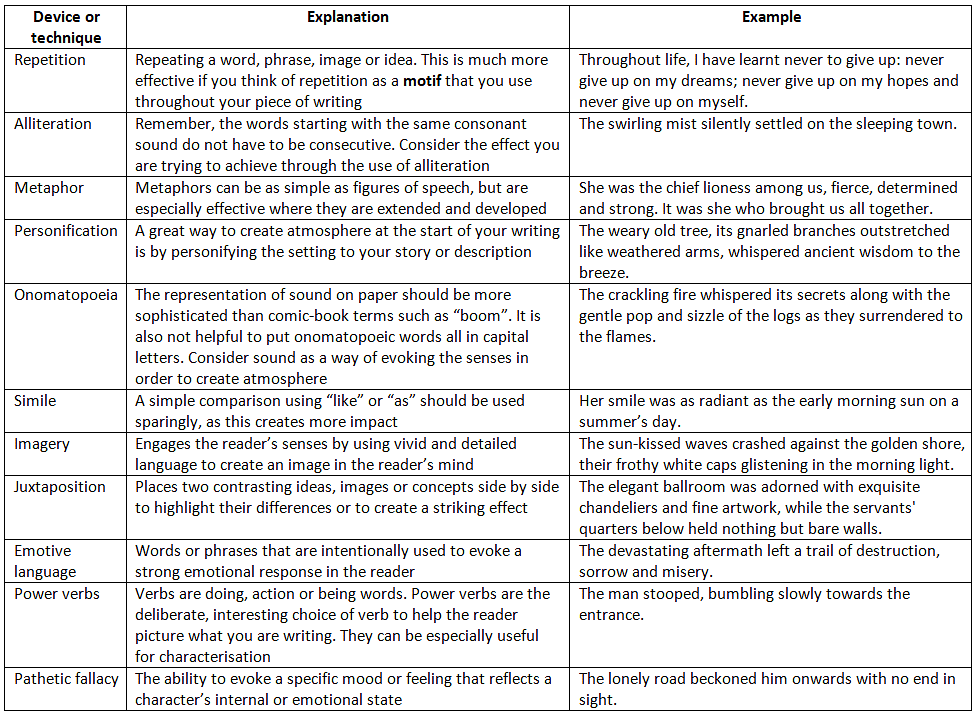
Top Tips
- Ensure that your written piece is well-structured and offers a thoughtful interpretation of your chosen topic.
- Demonstrate your skill in crafting a narrative by including moments of tension and drama to engage your readers.
- Utilize character development to create realistic and relatable protagonists and supporting characters.
- Avoid using cliches or overly familiar storylines, like deserted cabins in the woods, to maintain originality.
- Avoid simply narrating a sequence of events; instead, explore creative ways to narrate your story beyond a mere chronological sequence.
- Include the inner thoughts and emotions of your characters, not just their actions, to add depth to your storytelling.
- Avoid unnecessary complexity in your language; simple words and sentences can often have a powerful impact on readers.
- Begin your story at a central setting to establish the tone and atmosphere from the start, rather than focusing on the buildup.
- Every word you choose should contribute to the overall mood and impact you wish to convey to your audience.
- Vary the lengths of your sentences and paragraphs to maintain a dynamic style and tone throughout your narrative.
- Use dialogue judiciously; only incorporate dialogue that advances the plot and ensure correct punctuation.
- Consider the underlying message of your story and how your characters embody or reflect this message.
- Choose a narrative perspective that best suits the storytelling requirements of your narrative.
|
17 videos|45 docs
|

|
Explore Courses for Year 11 exam
|

|
















